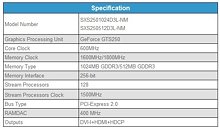Thursday, November 26th 2009

SPARKLE Launches World's First GeForce GTS 250 Graphics Card with Low Profile Design
SPARKLE Computer Co., Ltd., the professional VGA card manufacturer and supplier, today introduced the SPARKLE GeForce GTS250 Low Profile Graphics Card, the world's first low profile graphics card based on GeForce GTS250 graphics chip, providing powerful 3D performance and amazing home theater experience to HTPC enthusiasts.
Consummately designed low profile, the PCB height of the SPARKLE GeForce GTS250 Low Profile Graphics Card is 6 cm,only half the height of ordinary Graphics Card with full profile design, which makes the SPARKLE GeForce GTS250 Low Profile Graphics Card to be the best partners for HTPC. HTPC enthusiasts don't need to worry about the inconvenience caused by narrow space HTPC chassis and full profile designed graphics cards. With low profile design, the SPARKLE GeForce GTS250 Low Profile Graphics Card not only can easily meet the HD video playback and DX10 gaming demand from HTPC users, but also can easily satisfy the requirements from SSF, mini-chassis and industry PCs which demand compact and practical graphics card.1024MB/512MB Large-Capacity GDDR3 Memory
Today's game, such as Crysis, Alone in the Dark 5, Stalker: clear sky, they normally use a large number of bump texture, transparent texture to describe faces of characters and render realistic gaming scenes, so these games put higher demands on the capacities of video memory. The SPARKLE GeForce GTS250 Low Profile Graphics Card comes with incredible large 1024MB/512MB and high speed GDDR3 video memory can let mainstream users pass the 3D Mark Vantage High Test which strictly demand at least 512MB video memory. Meet the needs of a large number of 3D games, allowing the gamers to enjoy the pleasure brought by 3D games.
Single 6pin Power Supply
Today's GTS250 series graphics card is equipped dual 6pin power supply to run 3D games and HD movies. By strong RD team, SPARKLE GTS250 Low Profile graphics cards decrease the power consumption and it's only occupy 1 single 6pin power supply .With environmental protection conception inside, this eco-friendly function will dramatically reduce power consumption and heat emissions, effectively against global warming and manage to do energy conservation.
Native HDMI Support
In order to keep pace with HD tideway, the SPARKLE GeForce GTS250 Low Profile Graphics Card feature native HDMI support on PCB. Now the SPARKLE GeForce GTS250 Low Profile Graphics Cards passed the rigorous HDMI ATC certification tests in High-Definition Media Interface Authorized testing center, they can deliver vivid HD gaming audio and video through one single cable, provide more convenience to pc games and video enthusiasts to play games or watch HD videos on their HD TV.
All Solid Capacitors
Equipped all solid capacitors with lower power loss, provide more stable and longer product lifespan.
Cooling System
Exquisitely made cooling fans, which have quiet and high performance thermal compound . Specially equipped heat sink to cool the MOS circuit and memory to bring the most comprehensive cooling solution to ensure optimal thermal dissipation even after years of use.
2nd Generation Pure Video HD
High-definition video decoder and post-processor completely offload the CPU load and delivers unprecedented picture clarity, smooth video and accurate color for movies and video.
Full Microsoft DirectX 10 Support
DirectX 10 GPU with full Shader Model 4.0 support,delivers unparalleled levels of graphics realism and film-quality effects.
NVIDIA PhysX
GeForce GPU support for NVIDIA PhysX technology, enabling a totally new class of physical gaming interaction for a more dynamic and realistic experience with GeForce.
NVIDIA CUDA Technology
CUDA technology unlocks the power of the GPU's processor cores to accelerate the most demanding system tasks such as video transcoding delivering up to 7x performance over traditional CPUs.
Consummately designed low profile, the PCB height of the SPARKLE GeForce GTS250 Low Profile Graphics Card is 6 cm,only half the height of ordinary Graphics Card with full profile design, which makes the SPARKLE GeForce GTS250 Low Profile Graphics Card to be the best partners for HTPC. HTPC enthusiasts don't need to worry about the inconvenience caused by narrow space HTPC chassis and full profile designed graphics cards. With low profile design, the SPARKLE GeForce GTS250 Low Profile Graphics Card not only can easily meet the HD video playback and DX10 gaming demand from HTPC users, but also can easily satisfy the requirements from SSF, mini-chassis and industry PCs which demand compact and practical graphics card.1024MB/512MB Large-Capacity GDDR3 Memory
Today's game, such as Crysis, Alone in the Dark 5, Stalker: clear sky, they normally use a large number of bump texture, transparent texture to describe faces of characters and render realistic gaming scenes, so these games put higher demands on the capacities of video memory. The SPARKLE GeForce GTS250 Low Profile Graphics Card comes with incredible large 1024MB/512MB and high speed GDDR3 video memory can let mainstream users pass the 3D Mark Vantage High Test which strictly demand at least 512MB video memory. Meet the needs of a large number of 3D games, allowing the gamers to enjoy the pleasure brought by 3D games.
Single 6pin Power Supply
Today's GTS250 series graphics card is equipped dual 6pin power supply to run 3D games and HD movies. By strong RD team, SPARKLE GTS250 Low Profile graphics cards decrease the power consumption and it's only occupy 1 single 6pin power supply .With environmental protection conception inside, this eco-friendly function will dramatically reduce power consumption and heat emissions, effectively against global warming and manage to do energy conservation.
Native HDMI Support
In order to keep pace with HD tideway, the SPARKLE GeForce GTS250 Low Profile Graphics Card feature native HDMI support on PCB. Now the SPARKLE GeForce GTS250 Low Profile Graphics Cards passed the rigorous HDMI ATC certification tests in High-Definition Media Interface Authorized testing center, they can deliver vivid HD gaming audio and video through one single cable, provide more convenience to pc games and video enthusiasts to play games or watch HD videos on their HD TV.
All Solid Capacitors
Equipped all solid capacitors with lower power loss, provide more stable and longer product lifespan.
Cooling System
Exquisitely made cooling fans, which have quiet and high performance thermal compound . Specially equipped heat sink to cool the MOS circuit and memory to bring the most comprehensive cooling solution to ensure optimal thermal dissipation even after years of use.
2nd Generation Pure Video HD
High-definition video decoder and post-processor completely offload the CPU load and delivers unprecedented picture clarity, smooth video and accurate color for movies and video.
Full Microsoft DirectX 10 Support
DirectX 10 GPU with full Shader Model 4.0 support,delivers unparalleled levels of graphics realism and film-quality effects.
NVIDIA PhysX
GeForce GPU support for NVIDIA PhysX technology, enabling a totally new class of physical gaming interaction for a more dynamic and realistic experience with GeForce.
NVIDIA CUDA Technology
CUDA technology unlocks the power of the GPU's processor cores to accelerate the most demanding system tasks such as video transcoding delivering up to 7x performance over traditional CPUs.


51 Comments on SPARKLE Launches World's First GeForce GTS 250 Graphics Card with Low Profile Design
Anyone else? :twitch:
idiotic design.
And low to me implies the height of the card, I.E single slot not width of card.
Which seems irrelevant seeing as most of the time the end is the size of a standard bracket.
The red line below. That's the height.
This below marks the length of the expansion card:
Normally as the VGA connector is a cable that goes to the top of the bracket.
This is the first card I've seen with a different bracket.
That's fucktarded :laugh:
I don't care if that's what its called its silly.
That's width :laugh:
For as long as I've been in computers (1994), half-height, low-profile, full-height, full-length, half-length have been pretty standard terms regarding expansion cards.
The expansion card is seated perpendicular to the plain of the motherboard. Hence that dimension is the height of the expansion card.
Best low-pro card I've found was a 9800GT, this is slightly faster I believe.
If you handed a card to a regular person and asked for the width, they would give you what you said the height was.
It should be measured in the same way the case is, I.E standardised across all components.
You wouldn't say the width of your desktop was the height after all.
There's stuff like this in the medical world as well, inefficiencies and inconsistencies that really should be changed.
: ]
If you disagree with me that's fine but don't assume I'm ignoring you or being an idiot thank you kindly.
Anyway, if its not loud, it may be one of the best of countless rebranded cards...
More people would say width then height other then people in the computer world.
That would make us lot still a minority, so industry standard vs real world standard.
That's my argument : ]
And with that in mind its silly for the computer industry to do the opposite of what the rest of the world does.
Edit: Vertical measurement should always be height, when in the majority of cases these cards lay horziontally thus making height how many slots the card takes up.
By every other standard in the world and by the definition of height.
The rest of the world just lost the game! ;)
Let this be the last off-topic post.
www.sparkle.com.tw/award.asp
Unfortunately no low profile bracket in the box.
[OFF-TOPIC] Panther, don't be stupid. It's an industry standard. Your mother may or may not know what a hard drive is [hint: not "memory"], but that doesn't change the fact that your semantics are flat out wrong. Your argument boils down to "you can call anything anything," and while true, that doesn't make you correct, nor does popular opinion. If the masses are ignorant, that doesn't change fact. [/OFF-TOPIC]